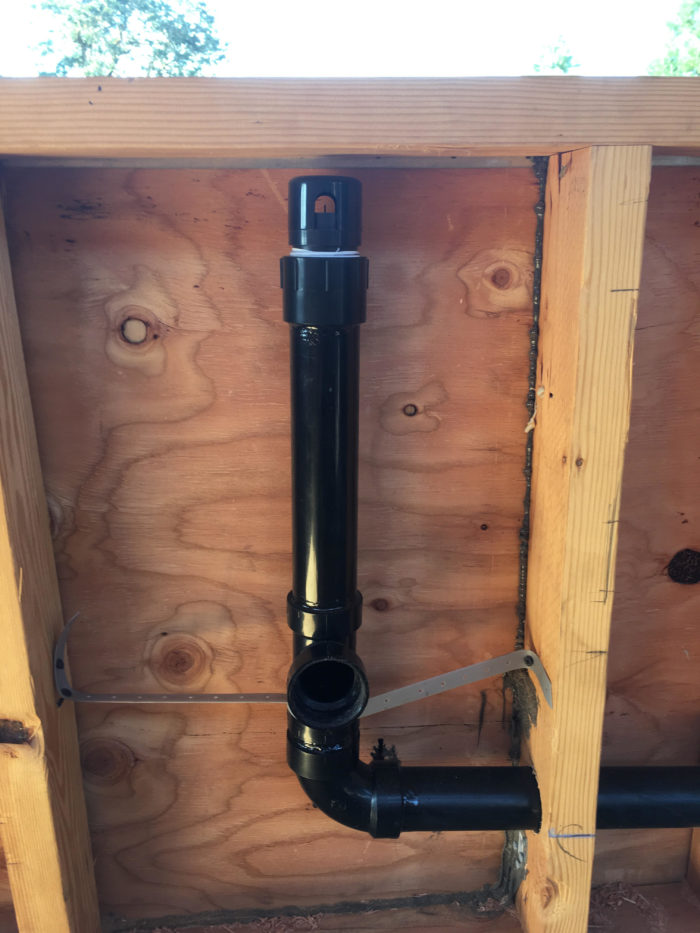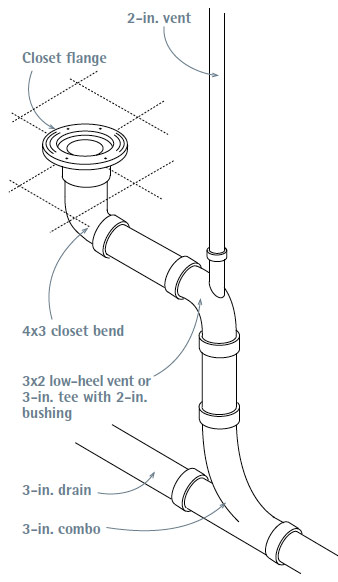The Benefits of Proper Ventilation in Your Plumbing System
The Benefits of Proper Ventilation in Your Plumbing System
Blog Article
What are your thoughts on The Upsides of Proper Ventilation in Plumbing Design?

Correct air flow in plumbing systems is usually neglected, yet it is critical for maintaining the functionality and security of your home's plumbing. Air flow aids manage air pressure, avoid the accumulation of unsafe gases, and make certain the reliable elimination of waste. In this guide, we will check out the significance of appropriate pipes air flow, exactly how it functions, and the benefits it gives your pipes system.
How Ventilation Functions in Pipes Solutions
Atmospheric Pressure Law
Correct air flow preserves well balanced atmospheric pressure within the pipes system. When water flows through pipes, it displaces air. Without adequate air flow, this displacement can create adverse stress, leading to slow drains pipes or siphoning of water from traps, which can trigger unpleasant odors to seep into the home.
Preventing Sewer Gas Build-up
One of the most crucial features of pipes vents is to avoid sewer gases, such as methane and hydrogen sulfide, from gathering within the home. These gases can position major health threats and are extremely flammable. Vent pipelines permit these gases to get away securely outside.
Assisting in Waste Elimination
Ventilation helps in the reliable removal of wastewater by protecting against airlocks in the drainage system. When air can stream freely with the vents, it permits water and waste to flow efficiently via the pipes, decreasing the danger of obstructions and back-ups.
Advantages of Proper Ventilation
Enhanced System Efficiency
Properly aerated plumbing systems run much more efficiently, with fewer obstructions, faster draining, and less pressure on the pipes. This efficiency expands the life-span of the plumbing system.
Improved Air High Quality
By stopping sewage system gases from entering your home, correct ventilation contributes to better interior air high quality, making your living environment healthier and extra comfortable.
Stopping Water Damage
Adequate ventilation aids protect against water from being siphoned out of catches, which can bring about sewer gases getting in the home and creating water damage with time.
Steps to Make Certain Proper Air Flow
Consulting Pipes Codes
Always seek advice from local plumbing codes when developing or modifying your plumbing system. These codes provide the needed guidelines for appropriate airing vent and guarantee your system meets safety and security standards.
Routine Assessment and Maintenance
Routine assessments can assist determine potential ventilation problems before they end up being significant troubles. Maintenance jobs, such as cleansing vent pipes and checking for clogs, are crucial for keeping the system in good working order.
Professional Setup
For new setups or significant alterations, it's a good idea to employ an expert plumbing professional. They have the experience to guarantee the air flow system is properly developed and mounted according to code.
Comprehending Air Flow in Plumbing
Air flow in plumbing refers to the network of pipelines that allow air to flow with the water drainage system. These vents offer multiple purposes, including regulating atmospheric pressure within the pipes, preventing drain gases from entering the home, and helping in the smooth circulation of wastewater.
Kinds Of Plumbing Vents
Key Stack Vent
The major stack air vent, also called the vent stack, is the key air vent in a pipes system. It expands from the main drain align with the roof covering, permitting gases to run away and fresh air to get in the system.
Branch Vent
Branch vents attach to the major pile air vent and offer specific fixtures, such as sinks, toilets, and showers. These vents guarantee that each fixture has sufficient air flow to work appropriately.
Air Admittance Valve (AAV).
An Air Admission Valve (AAV) is a one-way shutoff that allows air to enter the plumbing system without the demand for a standard air vent pipe expanding via the roof covering. AAVs are typically used in restorations or areas where setting up a conventional air vent is impractical.
Indications of Poor Air Flow in Pipes.
Slow Draining Fixtures.
If your sinks, tubs, or toilets are draining gradually, maybe a sign of bad ventilation. Insufficient air flow can develop a vacuum impact, making it challenging for water to drain pipes effectively.
Gurgling Seems.
Gurgling sounds originating from drains pipes are usually an outcome of air being sucked with water traps as a result of unfavorable stress in the pipes. This is a clear sign of not enough ventilation.
Undesirable Odors.
Sewer odors inside your home are a warning that your pipes system is not effectively ventilated. This can mean that sewer gases are not being effectively aired vent outside, leading to possibly harmful problems.
Common Air Flow Errors.
Poor Vent Sizing.
Utilizing small vent pipes can cause inadequate air flow and pressure discrepancies in the system. It's necessary to use vents that meet the specific requirements of your pipes system.
Improper Vent Positioning.
Positioning vents also much from the fixtures they serve can reduce their performance. Correct positioning makes certain that air can move freely and effectively through the system.
Ignoring Code Needs.
Building ordinance give details guidelines for plumbing ventilation. Overlooking these codes can cause a system that stops working to work properly and might bring about expensive repairs or carcinogen.
Conclusion.
Correct ventilation is a crucial part of any type of plumbing system, guaranteeing that it works successfully and securely. By recognizing the relevance of air flow, recognizing the indications of bad air flow, and taking steps to maintain your system, you can stop pricey concerns and shield your home's air top quality.
4 Things You Should Know About Your Plumbing Vents
What Plumbing Vents Are
Also called a vent stack, a plumbing vent is a vertical pipe attached to your drain line that runs through your roof. The plumbing vent pipe, or plumbing air vent, removes gas and odors from your plumbing system and allows fresh air to enter the pipes, helping the water to flow out of the drain pipes.
What Plumbing Vents Do
Plumbing vents have two basic functions. One of which is to allow unpleasant smelling wastewater and sewer gasses to escape your plumbing system instead of entering your home. Plumbing vent pipes are typically located on roofs, away from windows, to ensure the fumes exit the home completely.
The other function of the plumbing vent is to move fresh air into your plumbing system. This helps move water through every plumbing fixture in your house, like toilets and sink drains. Think of the way in which you need to let a little air into the bottle as you pour soda in order to make the drink flow smoothly.
Different Types of Plumbing Vents
True vent: This is the most common vent option. In simplest terms, a true vent is a vertical pipe attached to your drain line that exits through the roof. They often function as the main vent that other fixtures can connect to. Re-vent pipe or auxiliary vent: Attached to the drain line near specific plumbing fixtures, re-vent pipes run up and over to connect to the main vent. Common vent: Two plumbing fixtures installed on opposite sides of a wall are typically tied into the vent stack using something known as a sanitary cross. Wet vent: This venting option operates as a drain pipe and a vent at the same time. Wet vent drainage systems drain water from one fixture while venting the air from another. Although they’ve been used for over 100 years, wet vent systems have only recently been added to the plumbing code in many areas. If you’re planning on installing one in a bathroom remodel, make sure you check your local code prior to construction. Loop vent: For free-standing fixtures like kitchen island sinks, loop vents are ideal. These vent pipes run under the floor, rise from the P-trap, and create a loop inside the cabinet sink. Air admittance valve: An AAV is a one-way mechanical valve typically installed at the site of the plumbing fixture. AAVs allow venting to occur without having to tie into a larger venting system. They’re ideal for venting fixtures where you aren’t able to easily connect to an existing vent system. Common Plumbing Vent Issues
Although vent pipes typically don’t have water flowing through them, they’re still subject to many typical plumbing issues. For example, clogs are one of the most common problems associated with sewer vent pipes. If your vent pipe gets clogged, all of your plumbing fixtures tied into the vent stack will be affected.
A sink with a slow drain that bubbles and gurgles or a strong sewage smell around your toilet are both indicators that your toilet vent pipe is clogged. Because most vent pipes exit through the roof, old leaves, twigs or even a bird’s nest could be clogging the pipe.
Clogs in your vent pipe system cause a buildup of negative pressure, meaning that water won’t be able to flow out of your home very well. It’s similar to putting your finger over the opening of a straw to trap water inside. When you remove your finger, the water is able to flow out of the straw.
If you suspect you have any blockage in your vent, make sure you have a professional come examine the situation. Left unchecked, a blocked air vent can lead to other costly repairs, like leaks and sediment buildup.
Under Pressure
Pipe vents are essential aspects of a home’s plumbing system. Owning a home means learning about all sorts of things you never put much thought into before. But by understanding as much as you can about the important systems of your home, you can keep those budgets intact and those anxiety levels low.
https://www.homeserve.com/en-us/blog/home-improvement/plumbing-vents/

We were made aware of that editorial about What Is a Plumbing Vent and Why Is It Important from an acquaintance on a different site. If you please take the opportunity to promote this article if you enjoyed it. I appreciate reading our article about .
Click Here Report this page